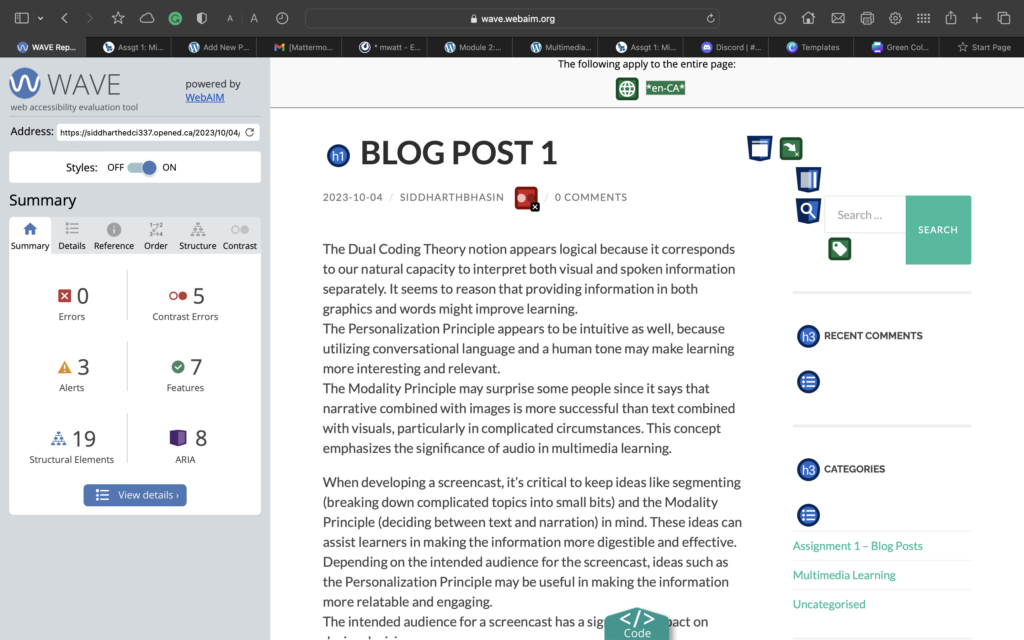Describe a meaningful learning experience that started with a story that you heard.
The story that sparked this learning trip was about a person who achieved their goal despite all odds. This character had a multitude of challenges, including financial difficulties, a lack of support, and personal insecurity. Their unwavering perseverance and resilience, on the other hand, eventually led to victory. The moral of the narrative was clear: overcoming adversity is necessary for success.
What made it impactful for you?
It highlighted the need of endurance and perseverance, encouraging the listener (in this case, me) to keep going in the face of hardship.
The character’s genuine problems helped to build empathy. The story’s message became more powerful and memorable as a result of this emotional connection.
The tale prompted thoughts on personal hardships and resilience. It gave a point of view that encouraged reconsidering personal goals and ways of overcoming obstacles.
The anecdote also served as a reminder that success often comes from tenacity and confronting issues head-on, which is an excellent lesson for both personal and professional development.
The narrative illustrated how an emotional connection, character development, and vivid imagery can create a story both enjoyable and successful.
Because the themes of persistence and struggle are universally accessible, the tale has a bigger impact on a broader audience. Stories like this have the ability to inspire and motivate others who are dealing with similar issues.
Stories of triumph over adversity have a global appeal, serving as sources of hope and encouragement throughout cultures and societies. In circumstances such as motivational speaking, schooling, or mentorship programs, the story might be utilized to emphasize important life skills and values.
It aided in recognizing core story elements like emotional connection as well as areas for improvement like pace and dialogue.
The story established a template for what makes a narrative compelling, inspiring later efforts to enhance storytelling abilities such as pacing, language, and symbolism.
What senses did it appeal to?
The story mostly played on the visual and emotional senses. The descriptive language painted vivid pictures, and the emotional arc of the tale – from adversity to accomplishment – created feelings of empathy, hope, and inspiration in the audience.
What storytelling techniques have you used instinctively?
By immediately engaging my emotions, particularly empathy and motivation, the tale drew me in and made the lessons more meaningful.
The comprehensive details in the story inspired powerful mental images, making the story more memorable and engaging.
The protagonist’s struggles and tribulations were shown in such a way that they became meaningful, resulting in a closer connection with the story.
Which ones require more work for you?
It’s tough for me to grasp the rhythm and flow of a story. Balancing the development, climax, and resolution to keep the audience interested without overwhelming or disappointing them requires extra consideration.
I should improve my use of speech to portray character traits and drive the tale forward. It’s vital that conversations sound genuine while yet being deliberate.
Deeper meanings may be transmitted by subtle clues and symbols, which is a complex skill I’m actively mastering.
Which techniques will you focus on moving forward?
I intend to practice structuring stories in a more compelling and balanced manner, ensuring that each segment adds to the overall.
I want to improve at utilizing dialogue as a tool for character development and plot progression, so it’s more intriguing and realistic.
Improving my ability to weave deeper concepts and themes into stories will be a goal because it adds depth and complexity to the story.
Finally, this learning experience not only taught me valuable life lessons, but it also provided insights into my storytelling abilities and prospects for improvement. By focusing on certain tactics, I aspire to become a more effective and engaging storyteller capable of connecting on a deeper level with audiences.
What made it impactful for you?
The protagonist’s triumph over adversity served as a powerful source of inspiration. It highlighted the importance of endurance and resilience, encouraging the listener (in this case, me) to persevere in the face of hardship.
Empathy was fostered by the character’s genuine hardships. Because of this emotional connection, the story’s message became more poignant and memorable.
The tale prompted thoughts on personal hardships and perseverance. It supported reconsidering personal goals and ways of overcoming obstacles.
The anecdote also served as a reminder that success often comes from tenacity and confronting issues head-on, which is a fantastic lesson for both personal and professional development.
The narrative illustrated how an emotional connection, character development, and vivid imagery can create a story both enjoyable and successful.
Because the themes of persistence and struggle are universally accessible, the tale has a bigger impact on a broader audience. Stories like this have the ability to inspire and motivate others who are dealing with similar issues.
Stories of triumph over adversity have a global appeal, serving as sources of hope and encouragement throughout cultures and societies. In circumstances such as motivational speaking, schooling, or mentorship programs, the story might be utilized to emphasize important life skills and values.
It aided in recognizing core story elements like emotional connection as well as areas for improvement like pace and dialogue.
The story established a template for what makes a narrative compelling, inspiring later efforts to enhance storytelling abilities such as pacing, language, and symbolism.
What storytelling techniques have you used instinctively?
By immediately engaging my emotions, particularly empathy, and motivation, the tale drew me in and made the lessons more meaningful.
The comprehensive details in the story inspired powerful mental images, making the story more memorable and engaging.
The protagonist’s struggles and tribulations were shown in such a way that they became meaningful, resulting in a closer connection with the story.
It’s tough for me to grasp the rhythm and flow of a story. Balancing the development, climax, and resolution to keep the audience interested without overwhelming or disappointing them requires extra consideration.
I should improve my use of speech to portray character traits and drive the tale forward. It’s vital that conversations sound genuine while being deliberate.
Deeper meanings may be transmitted by subtle clues and symbols, which is a complex skill I’m actively mastering.
Which techniques will you focus on moving forward?
I intend to practice making my stories more engaging and balanced by ensuring that each segment contributes to the overall.
I’d like to get better at using dialogue as a tool for character development and plot progression so that it’s more engaging and realistic.
Improving my ability to include deeper concepts and themes in stories will be a goal because it adds depth and complexity to the story.
Finally, this learning experience not only taught me valuable life lessons, but also offered me insights into my storytelling abilities and created prospects for development. I aspire to become a more effective and engaging storyteller capable of connecting on a deeper level with audiences by concentrating on certain tactics.



Recent Comments